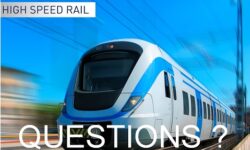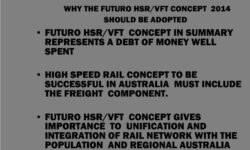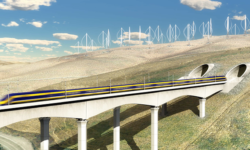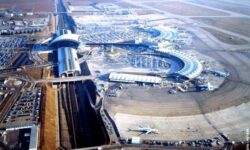FUTURO CONCEPT “HSR/FFR” AUSTRALIA
HSR and CONTAINERISED FREIGHT
RE: High Speed Rail (HSR)/FAST FREIGHT RAIL (FFR)
No. 2 Newcastle – Sydney – Melbourne
We do appreciate any support for the Inland Rail Melbourne to Brisbane, bypassing Sydney is fancy land. However as you might agree with it a couple of facts:
- That relatively minute investment of 2015 $2.5B, increased to $4B, in 2023 Dr. Kerry Schott report put it at $31B, we put it at well over the $100B. Involves old Technology and filling in all the missing rails for continuous line status.
- It would allow to bypass the congested Sydney Freight rail network well that was the original idea.
Though we did not start our mission involving the Bulk and Containerised Freight Corridor, its becoming increasingly evident that an opportunity exists here to marry the FUTURO HSR Concept with High Speed Containerised Freight (max. 20T axle load) along the same but completely new dedicated corridor that would then bypass/eliminate the congested Sydney network. The importance of serving Sydney is fundamental as is borne out in our presentation.
On this basis, within the FUTURO Concept we have identified the IR rail link between Wagga Wagga (North Albury) and Narrabri, common with our masterplan concept, as having very low priority and could be kept as contemporary designed and used as a shuttle service, using the existing technology upgrade but becomes integrated via intermodals with the FUTURO innovative network at the South of Wagga Wagga (North Albury) and to the North of Narrabri, connecting to a Brisbane-Narrabri-Newcastle – Sydney – Wollongong-Nowra-Canberra-Jindabyne-North Albury-Melbourne
The day I attended the Moss Vale seminar on the HSR in 2013. I asked a question about the validity of having a high speed bulk freight network to which a answer was given back that for bulk freight the high speed was not warranted. Since then I have attended other Rail conferences eg. Moree in March 2014, where the industry in fact has been calling for a high standard network be built which in fact would see bulk freight trains travel at much higher maximum speeds than the 80km/hr and in fact could be in the order of 190 - 200 km/hr. We suggest Containerised freight at average speeds 120-160km/hr.
Recently (2014), I attended an EOI meeting in Wollongong, by the NSW government, for the completion and operation of the Maldon to Dumbarton Railway. The overall feeling of the participants was that it would not be able to operate on its own and needed integration and upgrading of interconnecting components, like Port Kembla end, the Sydney and Sydney SW network and possibly the Newcastle network. This is, indeed, evidence of the Sydney congestion mentioned above, and a sincere requirement by industry for it to be resolved for better productivity. It became obvious to us after the EOI meeting that a marriage of the Melbourne Brisbane Inland Rail (IR) and the High Speed Rail for the SE and East Coast is definitely something to consider.
What’s happening in Europe and also the US?
The Bulk rail process is becoming more and more a suitable option in the European system, if we look at the next step on the Lyon–Turin HSR there is a slotted night time were Heavy freight will be allowed on the rail line to alleviate the burden of the road and also to reduce the CO2 emission, the report states the following;
The bulk/heavy freight transportation;
Lyon-Turin Freight (LTF) estimated that the historical line saturation will occur between 2015 and 2020, about 3 million trucks will cross the Alps, while the new line will allow:
- To transfer 1 million trucks per year to rail, which correspond to null the traffic at the Frejus Motorway Tunnel.
- To transport 40Mt freights in the 2030. Promoter estimation made on 1991.
- To transport 20Mt freights in 2020. Promoter estimation made in 1997.
- The joint SNCF-RFF-FS study of March 2000 estimated via a conservative formula a capacity of 20Mt/year, corresponding to 185 freight plus 66 passengers’ trains daily (251 trains in total).
- The study performed by Polinomia on May 2004, shown a capacity of 27Mt/year, corresponding to 150 freight plus 70 passengers trains daily, assuming improvement of the line and the electrical power stations.
In Australia, we are not about asking the Federal Government reversing its program on the MBIR apparently now increased from the 2.5B to $4B and Dr. Kerry Schott independent report 2023 estimated it at $31B, our thoughts more like $100B to complete and with old technology. This capitalisation however only allows the missing links to be built, but does nothing towards raising the level of standards being built. The motto of the Moree conference (2014) was "do it once and do it right". There is an industry call for the Inland rail be built to high standards. These high standards are also harmonious with standards of the HSR. ie. Gradient and Geometry. In discussion with accredited participants a new word description was born "General" HSR rail concept.
Some of this $31B should be redirected to at least fund feasibilities of our FUTURO concept.




